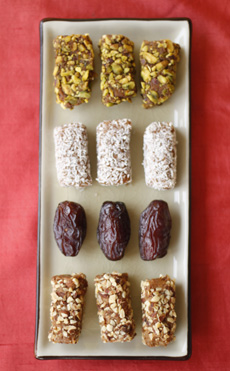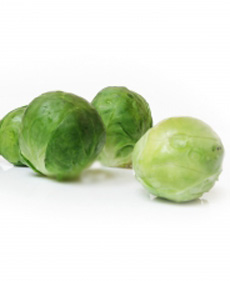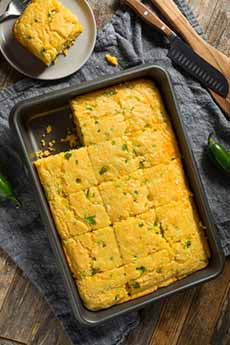
[1] Jalapeño cornbread, cut into squares (photo © Bhofack2 | Panther Media).

[2] Jalapeño cornbread muffins with Cheddar cheese. Here’s the recipe (photo © Vivacious Gourmet).
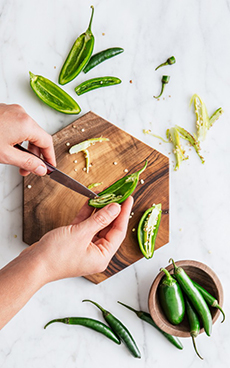
[3] The best way to de-seed and dice the chile is to first make a vertical cut and remove the seeds and pith (photo © Good Eggs).

[4] We prefer the red jalapeño color and flavor, but often make a red-and-green mix (photo © © Ball Horticultural Company).
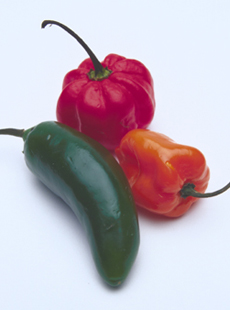
[5] If you’d like a hotter chile than jalapeno (green), substitute habanero or Scotch bonnet (photo © Ashley Foods Co. | Mad Dog 357).
|
|
Looking for a great jalapeño cornbread recipe?
Our upcoming Top Pick Of The Week, Deano’s Jalepeño Chips, got us to thinking about the other ways we enjoy jalapeño.
Among our favorites is jalapeño cornbread. The heat of the chile bits brings the already-wonderful sweet corn and butter flavors to a new height.
In some regions of America, cornbread is associated with southern food. But you don’t need a plate of barbecue or eggs and grits to enjoy its pleasures. Serve it anytime: for breakfast or lunch, with soups and salads, as a snack or in the dinner bread basket.
Marcus Samuelsson, the world-famous chef, a Harlem resident, opened a Southern comfort food in Harlem last year, Red Rooster. His recipe follows.
> The history of cornbread.
> The history of chiles.
> The different types of chile peppers: a photo glossary.
> Check out the year’s 18 chile pepper holidays below.
> April 6th is National Cornbread Day.
RECIPE: MARCUS SAMUELSSON’S JALAPEÑO CORNBREAD
Ingredients
1 cup cake flour
1 cup coarse yellow cornmeal
3/4 cup sugar
2-1/4 teaspoons baking powder
3/4 cup seeded and finely diced jalapeño chiles, red, green, or mix (2 to 3 large chile peppers)
1 1/2 teaspoons coarse kosher salt
1-3/4 cups sour cream
1-1/2 cups buttermilk
2 large eggs
1 large egg yolk
2 tablespoons unsalted butter, melted and cooled
2/3 cup corn kernels (fresh or thawed frozen)
Preparation
1. PREHEAT the oven to 325°F. Spray a 9-x-5-inch loaf pan with pan spray.
2. WHISK the flour, cornmeal, sugar, baking powder, and salt together in a bowl.
3. WHISK the sour cream, buttermilk, eggs, yolk, jalapeños, and melted butter together in another bowl until smooth. Pour the wet ingredients into the dry and stir until combined. Fold in the corn.
4. SCRAPE the batter into the loaf pan and smooth out the top. Bake until the bread is browned and pulling away from the sides of the pan, and a skewer poked into the center comes out clean—about 60 minutes.
5. COOL on a rack for 20 minutes. Run a knife around the sides of the pan to loosen the sides and turn out the loaf. You can cut it now but the slices will be rough-hewn. Otherwise, cool completely for a clean cut.
The bread will keep for four days, but freezing individual slices is better.
KNOW YOUR CHILES
Beyond jalapeño, how many other chiles have you had? Check out our Chile Glossary.
Is it spelled chile, chili or chilli?
The original Nahuatl (Aztec) word is chilli. The conquering Spanish spelled it chile. And many people use chili, a seeming middle ground between the first two. The choice is yours.
THE YEAR’S 18 CHILE PEPPER HOLIDAYS
January 16: International Hot & Spicy Food Day
January 22: National Hot Sauce Day
February, fourth Thursday: National Chili Day
May: National Barbecue Month
May: National Salsa Month
May 6: National Salsa Day
June: National Fresh Fruit and Vegetables Month
August 5: National Green Peppers Day
August 19: National Hot & Spicy Food Day
September 16: National Guacamole Day
October: National Pickled Peppers Month
October, 1st Week: National Pickled Peppers Week
October: National Chili Month
October: National Pickled Peppers Month
November: National Pepper Month
November 6: National Nacho Day
November 14: National Spicy Guacamole Day
December 12: National Pho Day
|





